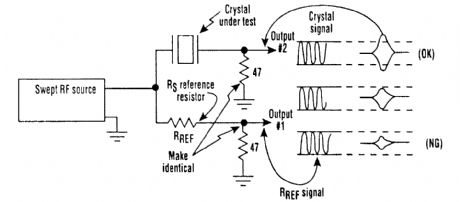Measuring and Test Circuit
EASY_CRYSTAL_IMPEDANCE_CHECKER
Published:2009/6/15 21:06:00 Author:May | From:SeekIC

On occasion, micropro c es s ors/micro c omputers and microprocessor crystals just aren't compati-ble with each other. Many microprocessor data sheets specify maximum values for a crystal's equiv-alent series resistance (RS) that aren't met by some crystals advertised for microprocessor/ microcomputer use. As a result, a crystal with an RSvalue greater than the maximum specified for the chip might cause problems, such as a balky or even inoperative clock oscillator.To tackle this problem, a suspected crystal can be given a quick check forRS with a simple test setup that consists of a sweep generator, oscilloscope, and three resistors (see the figure). When the frequency source is brought to the crystal's frequency, output 2 will maximize. If it exceeds the am-plitude of output 1, the crystal's RS value will be less than the RS reference resistor's value. If it doesn't exceed output 1's amplitude, the crystal's RS value is too large.
Reprinted Url Of This Article:
http://www.seekic.com/circuit_diagram/Measuring_and_Test_Circuit/EASY_CRYSTAL_IMPEDANCE_CHECKER.html
Print this Page | Comments | Reading(3)

Article Categories
power supply circuit
Amplifier Circuit
Basic Circuit
LED and Light Circuit
Sensor Circuit
Signal Processing
Electrical Equipment Circuit
Control Circuit
Remote Control Circuit
A/D-D/A Converter Circuit
Audio Circuit
Measuring and Test Circuit
Communication Circuit
Computer-Related Circuit
555 Circuit
Automotive Circuit
Repairing Circuit
Code: